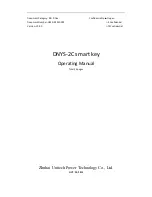
IAI3001D-01
Page 1 of 8
07/18
iVQ-E to R Range Installation and Operating Manual
This document provides necessary information for the installation and commissioning of the iVQ Range quarter-
turn electric actuator. Each unit is shipped from the factory with initial calibration of mechanical stops, cams
and switches completed for 0°
–
90° operation. However, these are general settings and serve as a starting point
for proper calibration of the actuator in its real-world application.
Only competent and trained personnel should install, maintain and operate iVQ actuators. Any work related to
an actuator must be carried out in accordance with this manual, accompanied manuals and related codes and
regulations. Local workplace health and safety rules should always be followed.
NOTE: Throughout the documentation we reference CLOCKWISE (CW)
rotation as moving in the CLOSE direction
and COUNTER-CLOCKWISE (CCW) rotation as moving in the OPEN direction.
Receiving / Inspection
•
Carefully inspect for shipping damage. Damage to the shipping carton is usually a good indication that it has
received rough handing. Report all damage immediately to the freight carrier and your seller.
•
After unpacking the product and information packet, please take care to save the shipping carton and any
packing material in case of product return or replacement. Verify that the item on the packing list or bill of
lading is the same as your own documentation. If there is any discrepancy, please contact the seller.
Storage
•
If the actuator cannot be installed immediately, store it in a clean dry environment. The actuator must be
protected from excess moisture and dust until you are ready to connect the electrical cables. The actuator
should not be installed outside unless it is powered up and has the proper conduit connections.
•
If the actuator is to be installed but cannot be wired, please don’t remove the plastic cable entry plugs. When
the actuator is wired, it is recommended to replace with water-proof conduit fittings.
•
Storage temperature should be within the standard operating temperature range of the actuator.


























